| |
|
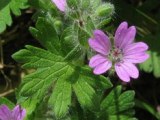 | |
| MaltaWildPlants.com by Stephen Mifsud |

|
| |
|
|
 |  |  |  |
| External Links: |
|
Misopates orontium (Lesser Snapdragon) |

Misopates orontium (PLANTAGINACEAE.)
Images for this profile are taken from the Maltese Islands after year 2000. |
|
| Nomenclature |
Species name : | Misopates orontium (L.) Raf. | Authority : | Carl von Linne, Sweden, (1707 - 1778) ;
Constantine Samuel Rafinesque-Schmaltz, Turkey, France, USA, (1783 - 1840) | Synonyms :
(basionym or principal syn.) |
|
Plant Family : | | English name(s) : | Lesser Snapdragon, Linear-leaved Snapdragon, Weasel's Snout | Maltese name(s) : | Papoċċi rqiq, Papoċċi tar-Raba | Status for Malta : | Indigenous. Present on the Maltese islands before man | Name Derivation : |
Misopates: "From the Greek words ""misos"" (hate) and ""patein"" (step on), with which its author meant that it would be a pity to step on this beautiful herb". (Greek origin ); 2 = from the Greek words "misos" (hate) and "patein" (step on), with which its author meant that it would be a pity to step on this beautiful herb (Greek);.
orontium: From the Greek word orontion, which is an old Greek name used for these plants already by the Italian physicist, Claudius Galenos, 129-210 AD. (Greek origin ); 2 = derived from the Greek word "orontion", which is an old Greek plant name used already by Galenos in the 2nd century (Greek).
| Remarks : | |
|
| Morphology and structure |
PLANT STRUCTURE: |
Character | Growth Form | Branching | Surface |
Description | | | |
General
Picture |  |  | 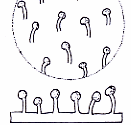 |
|
LEAVES: |
Character | Arrangement | Attachment | Venation |
Description | | | |
General
Picture |  |  |  |
| |
Character | Leaf Shape | Leaf Margin | Remarks |
Description | | | |
General
Picture |  |  |  |
|
FLOWERS: |
Character | Colour | Basic Flower Type | No. of Petals | No. of Sepals |
Description | Pink & Red Pink petals with deep red veins. | | 2 Upper and lower lip-like petals resting on each other. | 5 |
General
Picture | | 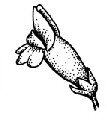 |  |  |
| |
Character | Inflorescence | Description | Ovary | Stamens |
Description | | The flower consists of 5 finger-like sepals and a corolla of 2 large and complex, pink petals (lips), resting on each other forming a closed tubular structure. The 2 lips, but especially the palate of the lower one are further decorated by deep red veins. Inside the flower, there are 4 stamens and a pistil, all close together and located at the roof of the upper lip. The spur is absent. | | |
General
Picture |  |  | 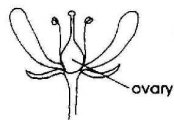 |  |
| |
Character | Scent | Average Flower Size | Pollen Colour | Other Notes |
Description | YES Mild sweet scent. | 8 x 8 x 15 mm (Length x Breadth x Depth). | Yellow | - |
|
SEEDS: |
Character | No. Per Fruit | Shape | Size | Colour |
Description | >200 | Irregular cylindrical to oval shape (Seed coat possess several ridges). | 1mm | Dark brown / Black |
General
Picture |  |  |  |  |
|
FRUIT AND OTHER BOTANICAL DATA: |
Character | Fruit Type | Colour of Fruit | Subterranean Parts | Other Notes |
Description | | Beige-Brown | | - |
General
Picture | 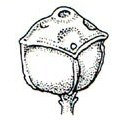 |  |  |  |
|
|
| Plant description and characters | |
Life Cycle: | Annual. |
Growth Form: | THEROPHYTE (annual plants, herbaceous) |
Habitat: | Steppe, abandoned agricultural areas, low garigue, sometimes escaping into agricultural areas. |
Frequency: | Frequent |
Localities in Malta: | Frequent besides wheatfields such as in Qormi, Siggiewi and Rabat. Also located in Wied Anglu, Mizieb and Bahrija. |
Plant Height: | 20-50cm. |
| Apr-Jul |
Protection in Malta: | Not legally protected till the last update of this website (2/Mar/2022) |
Red List 1989: | Not listed in the Red Data Book of the Maltese Islands |
Poison: | |
This annual plant produces several erect, stems which branch only at the lower part; sometimes just above ground level. The stem is glabrous but becomes hairy (with glandular hairs) at the upper part,approximately at the region of the flowers and fruit.
The short stalked leaves are linear to fusiform, glabrous, have an entire outline and a distinct depressed midrib. The leaf length varies according to the position on the plant. Leaves at the main stem are larger, about 50mm long by 4mm wide, whereas branched leaves are much smaller (20mm x 2mm) and more linear in shape. The plant forms a large stipule-like leaves arranged in 3 x whorls or opposite pairs which becomes irregularly leveled and then alternating towards up the stem. From the axils of these leaves grows out a small slender branch of about 4 - 10 linear leaflets. These leaflets are usually arranged in decussate opposite pairs.
The small, solitary flowers measure about 6mm diameter and 15mm deep. They are nearly sessile to the stem (just a 1mm pedicel) and arranged in an alternate fashion forming loose racemes. Like the leaflet stems, there is a large sessile leaf-like bract from which the flower grows. The flower have 5 long linear sepals of slightly unequal length. In the flower form the the bract and the 5 sepals seems to form a singular 6-unit symmetrically arranged structure - as if the flower have a 6-sepal calyx.
The corolla is bi-laterally symmetrical and composed of an upper and lower pink-lilac lips which forms a closed tube-like structure. The upper lip has 2 lobes and the lower has 3 and both, especially at the palate of the lower one, have deep red veins. There is no spur and the flower are slightly scented. Inside the flower there are the reproductive organs, composed of one central pistil and 2 pairs of stamen with swollen yellow anthers. Sometimes the anthers of each pair are so close together that they fuse together.
The fruit of the plant are oval, green, dehiscent poricidal capsules which when they ripen they turn beige-brown, becomes dry and hard and develops 3 openings from which the tiny (1mm), brown seeds escapes the fruit, mainly by swaying of the stems with wind or animals passing by.
|
|
| Information, uses and other details |
Nativity and Distribution
This plant is widespread in many areas around the world mainly in the continents of Africa, Europe and Asia. It is native to:
AFRICA : ( Eg: Cape Verde, Algeria; Egypt; Libya; Morocco; Tunisia Eritrea; Ethiopia; Sudan; Kenya)
ASIA: (eg: Iran; Israel; Jordan; Lebanon; Syria; Turkey; India; Nepal; Pakistan )
EUROPE: (eg: Austria; Belgium; Netherlands; Switzerland; Ukraine; Albania; Bulgaria; Greece; Italy; Romania; Yugoslavia; Portugal; Spain; Canary Islands) [WWW-26]
Synonyms
The plant is also referred to as Antirrhinum orontium and Antirrhinum orontium var. grandiflorum [WWW-26]
Food for Larvae
This plant can be used as food for the following larvae: Stenoptilia bipunctidactyla and Stenoptilia aridus [WWW-62]
Not much information has been found about this particular plant species. If you can supply further info to be included in this profile, please do not hesitate to email us pr by using the form found at the botom of this page. Full reference credits will be given accordingly. Thank you for your support!
|
|
| | |

